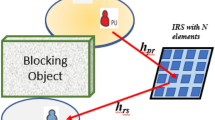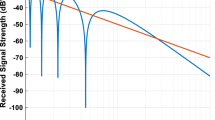Abstract
Amidst the factors that degrade the performance of a mobile wireless network (MWN), unnecessary handoff is considered to be one of the premier culprits since it aimlessly consumes the network resources. Most of the existing handoff algorithms proposed for MWN suffer from frequent unnecessary handoff as the primary decision of switching network cells is solely based on a single contributing factor, namely the received signal strength (RSS) that approximates the distance between a mobile node and access points. In practice, the RSS may not provide accurate approximation of the true distance as it fluctuates with wireless propagation impairments (such as shadowing, scattering, and reflection), leading to potential incorrect handoff decision within neighboring cells. In this paper, an improved estimation model for instantaneous distance between the mobile node and access point is formulated. Building upon this model, a new handoff technique is proposed by introducing two RSS thresholds and estimated distance verification, anticipating RSS fluctuations that may lead to handoff decision errors. The performance of the proposed handoff mechanism is thoroughly examined using numerical simulations and the acquired results demonstrate promising advantages of this proposed technique.










Similar content being viewed by others
References
Balakrishnan R, Akyildiz IF (2016) Local anchor schemes for seamless and low-cost handover in coordinated small cells. IEEE Trans Mob Comput 15(5):1182–1196
Fischione C, Athanasiou G, Santucci F (2014) Dynamic optimization of generalized least squares handover algorithms. IEEE Trans Wirel Commun 13(3):1235–1249
Ahmed A, Merghem-Boulahia L, Gaïti D (2011) An intelligent agent-based scheme for vertical handover management across heterogeneous networks. Ann Telecommun 66(9):583–602
Ahmad R, Sundararajan EA, Othman NE, Ismail M (2017) Handover in LTE-advanced wireless networks: state of art and survey of decision algorithm. Telecommun Syst 66(3):533–558
Ferretti S, Ghini V, Panzieri F (2016) A survey on handover management in mobility architectures. Comput Netw 94:390–413
Holis J, Pechac P (2008) Elevation dependent shadowing model for mobile communications via high altitude platforms in built-up areas. IEEE Trans Antennas Propag 56(4):1078–1084
Zhou Y, Ai B (2014) Handover schemes and algorithms of high- speed mobile environment: a survey. Comput Commun 47:1–15
Zola E, Kassler A (2016) Minimizing the impact of the handover for mobile users in WLAN: a study on performance optimization. Comput Netw 107(Part 2(1)):292–303
Mahmood A, Zen H, Othman AK (2015) An optimized travelling time estimation mechanism for minimizing handover failures and unnecessary handovers from cellular networks to WLANs. Int J Pervasive Comput Commun 11(1):2–16
Zhu X, Li M, Xia W, Zhu H (2016) A novel handoff algorithm for hierarchical cellular networks. China Commun 13(8):136–147
Sung NW, Pham NT, Yoon H, Lee S, Hwang WJ (2013) Base station association schemes to reduce unnecessary handovers using location awareness in femtocell networks. Wirel Netw 19(5):741–753
Kabiri S, Kalbkhani H, Lotfollahzadeh T, Shayesteh MG, Solouk V (2016) Technique for order of preference by similarity to ideal solution based predictive handoff for heterogeneous networks. IET Commun 10(13):1682–1690
Kustiawan I, Chi KH (2015) Handoff decision using a Kalman filter and fuzzy logic in heterogeneous wireless networks. IEEE Commun Lett 19(12):2258–2261
Kumar SA, Murthy KES (2016) Minimizing excessive handover using optimized Cuckoo algorithm in heterogeneous wireless networks. In: Proceedings of the 2nd international conference on computer and communication technologies. https://doi.org/10.1007/978-81-322-2526-3-16
Rahman MA, Salih QM, Zolkipli MFB (2015) Design a technique for minimizing unnecessary handoff in mobile wireless networks. In: Proceedings of the IEEE international conference on software engineering and computer systems, pp 218–222
Camp T, Boleng J, Davies V (2002) A survey of mobility models for ad hoc network research. Wirel Commun Mob Comput 2(5):483–502
Jana T, Banerjee J, Chakroborty I, Patra TS, Sarddar D, Naskar M, Biswas U (2011) Minimization of handoff failure and cellular traffic by introducing IEEE 802.11b WLAN router in the handoff region. In: Unnikrishnan S, Surve S, Bhoir D (eds) Advances in computing, communication and control. ICAC3 2011. Communications in computer and information science, vol 125. Springer, Berlin
Kim DH, Kim JD (2013) Design and implementation of location-based Handoff scheme for multimedia data. In: Kreowski HJ, Scholz-Reiter B, Thoben K D (eds) Dynamics in logistics. Lecture notes in logistics. Springer, Berlin
Berg M, Kreveld M, Overmars M, Schwarzkopf O (1996) Computational geometry: algorithms and applications. Springer, Berlin
Zheng B, Lee WC, Lee DL (2004) On semantic caching and query scheduling for mobile nearest-neighbor search. Wirel Netw 10(6):653–664
Cacciapuoti AS, Caleffi M, Paura L, Rahman MA (2015) Channel availability for mobile cognitive radio networks. J Netw Comput Appl 47:131–136
Asyhari AT, ten Brink S (2017) Orthogonal or superimposed pilots? A rate-efficient channel estimation strategy for stationary MIMO fading channels. IEEE Trans Wirel Commun 16(5):2776–2789
Asyhari AT, i Fàbregas AG (2014) MIMO block-fading channels with mismatched CSI. IEEE Trans Inf Theory 60(11):7166–7185
Rahman MA, Kabir MN, Azad S, Ali J On mitigating hop-to-hop congestion problem in IoT enabled intra-vehicular communication. In: Proceedings of the IEEE international conference on software engineering and computer systems, pp 213–217
Rahman MA, Ali J, Kabir MN, Azad S (2017) A performance investigation on IoT enabled intra-vehicular wireless sensor networks. Int J Autom Mech Eng 14:3970–3984
Rahman MA, Asyhari AT, Bhuiyan MZA, Salih QM, Zamli KZB (2018) L-CAQ: joint link-oriented channel-availability and channel-quality based channel selection for mobile cognitive radio networks. J Netw Comput Appl 113:26–35
Acknowledgments
M. A. Rahman and A. T. Asyhari acknowledge support from the Malaysian Ministry of Higher Education-Fundamental Research Grant Scheme (FRGS) grant no. RDU190165.
Author information
Authors and Affiliations
Corresponding authors
Additional information
Publisher’s note
Springer Nature remains neutral with regard to jurisdictional claims in published maps and institutional affiliations.
Rights and permissions
About this article
Cite this article
Rahman, M.A., Salih, Q.M., Asyhari, A.T. et al. Traveling distance estimation to mitigate unnecessary handoff in mobile wireless networks. Ann. Telecommun. 74, 717–726 (2019). https://doi.org/10.1007/s12243-019-00713-x
Received:
Accepted:
Published:
Issue Date:
DOI: https://doi.org/10.1007/s12243-019-00713-x




